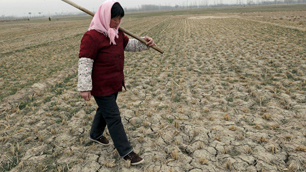China to spur rice output as drought shrivels wheat
Beijing (AFP) – China called Wednesday for higher rice output to offset damage to its wheat crop in the drought-stricken north and pledged $1 billion in spending to battle a problem the UN warned could be “very serious”. The drought affecting large swathes of northern China is the worst in six decades in many areas and has left key grain-growing regions with no real rainfall in more than three months. At a meeting on Wednesday chaired by Premier Wen Jiabao, the government decided to allocate funds to pay rice-growers higher prices for their grain in a bid to spur production, said a statement by the State Council, or Cabinet. The statement did not say how much of the 6.7 billion yuan in anti-drought spending would be earmarked specifically for that purpose. Other spending would go toward diverting water to affected areas, constructing emergency wells and irrigation facilities, and other measures to combat the dry spell. The State Council warned the situation could worsen, saying rainfall across northern China for the foreseeable future would remain “persistently below normal levels and major rivers will continue to be generally dry.” … The dilemma could not have come at a worse time for the government, which is struggling to cap soaring prices of food and other key goods. On Tuesday, the central bank announced the third interest rate hike in four months, one of a series of macro-economic levers it has pulled to tame inflation — which has a history of sparking unrest in China. The drought has become the top issue of public concern in China and cast a pall over the country’s Lunar New Year holiday celebrations, which are continuing this week. Both President Hu Jintao and Wen paid separate visits to stricken areas during the height of the holiday last week and called for “all-out efforts” to fight the drought. Besides the impact on farmland, nearly three million people are suffering from drinking water shortages. The UN’s Food and Agriculture Organisation (FAO) issued a warning Tuesday over the impact on the winter wheat crop, a key harvest for the world’s biggest producer of the grain. “The ongoing drought is potentially a very serious problem,” the Rome-based agency said. The eight affected grain-farming provinces produce more than 80 percent of China’s winter wheat. More than five million hectares (12.4 million acres) of crops have been damaged — an area half the size of South Korea, China’s drought control agency has said. … The drought is the worst in 60 years in Shandong, the nation’s second-biggest wheat producer, where rainfall in recent months has been 85 percent below normal. Hebei province in northern China was already channeling large amounts of water from the Yellow River, and was poised to divert more to affected areas, the China Daily reported. …
China to spur rice output as drought shrivels wheat
February 9, 2011 (CBC News) — Wheat prices continued to spike Wednesday as Chinese officials said they were preparing for a long, severe drought in the country’s already-parched major grain-growing area. March wheat settled up 1.3 per cent, to $8.86 US a bushel, on the Chicago Board of Trade after rising as high as $8.9325 earlier in the day. Prices have gone up about 35 per cent since mid-November. The prospect of a poor harvest on the North China Plain raised the likelihood the world’s largest consumer of wheat might have to increase imports, putting more pressure on stretched global supplies. China has said the drought is mainly affecting Shandong, Jiangsu, Henan, Hebei and Shanxi, which grow more than two-thirds of the country’s wheat. “What we are doing now is making full preparations to deal with a severe, long-lasting drought,” said the director of emergency relief at Shandong’s weather bureau. Like many Chinese officials, he would not give his name. State news media have said the eastern province of Shandong faces its worst drought in 200 years, and the other affected provinces in the north and east face their worst in 60 years. Shortages of drinking water have affected 2.6 million people. The UN’s food agency has warned that the drought is driving up prices. Average flour prices rose more than eight per cent in January from the previous two months. …
